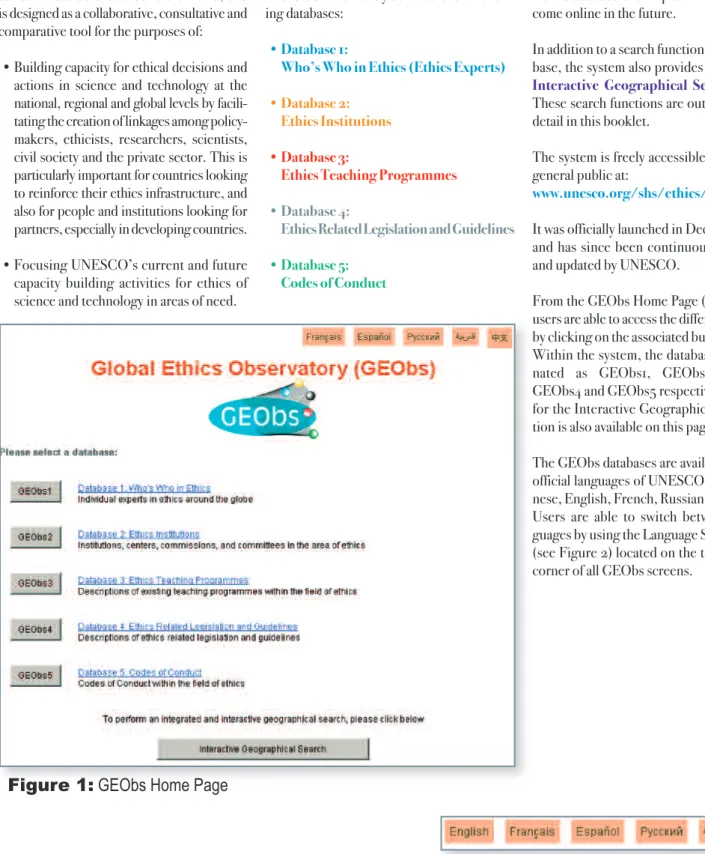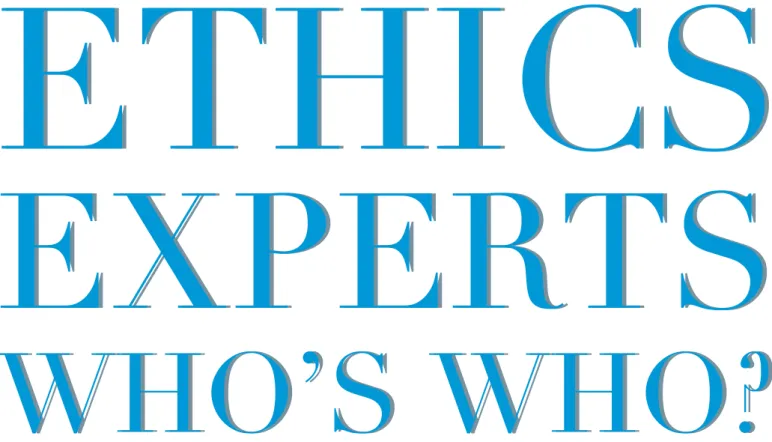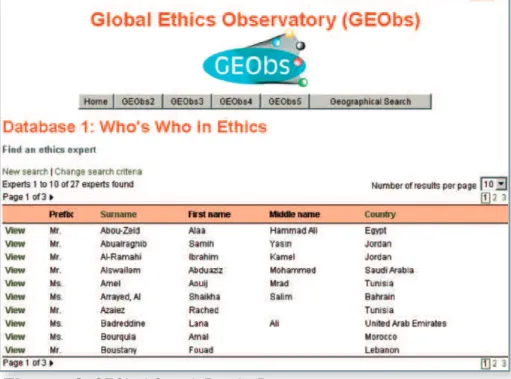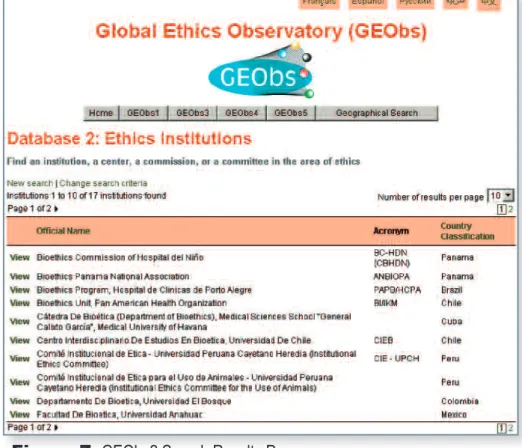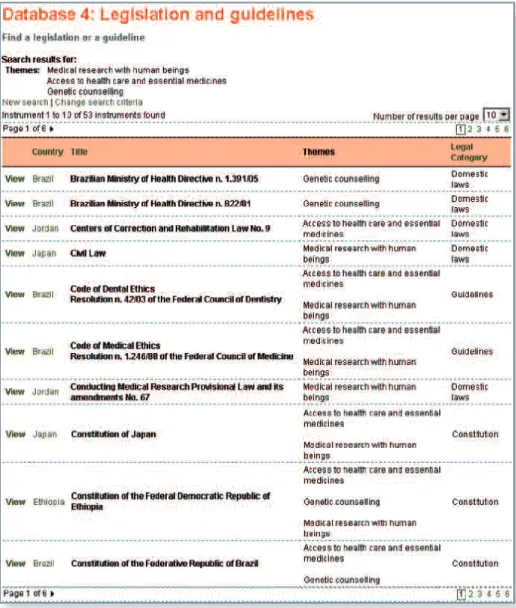SCIENCE &
TECHNOLOGY
ETHICS
INSTITUTIONS
ETHICS
TEACHING PROGRAMMES
ETHICS
RELA
TED
LEGISLA
TI
ON
&
GUIDELINES
CONTRIBUTIONS
TO GEObs
INTERA
CTIVE
GEOGRAPHIC
AL
SEARCH
WHO’S
WHO?
ETHICS
EXPER
TS
CODES
OF CONDUCT
Livros Grátis
http://www.livrosgratis.com.br
Design & Production: Julia Cheftel
Photos, courtesy of:
UNESCO/Niamh Burke, Dominique Roger, Serge Daniel
Morguefile.com/Daniel Wildman, Clara Natoli, Arturo Delfin
National Institute of Standards and Technology
European Commission
Luna Innovations
WHO/P Virot
UN Photo/Tim McKulka
Sandia National Laboratories, SUMMIT™ Technologies www.mems.sandia.gov
NASA Center for Nanotechnology
Réseau d’Imagerie Parisien
Printed by: GRAPH 2000, France
Paper: Condat Gloss
GLOBAL ETHICS
OBSERVATORY
GLOBAL ETHICS
OBSERVATORY
www.unesco.org/shs/ethics/geobs
Division of Ethics of Science and Technology
Sector for Social and Human Sciences
INTRODUCTION
INTRODUCTION
The Global Ethics Observatory (GEObs)is a system of databases with worldwide cover-age in bioethics and other areas of applied ethics in science and technology such as en-vironmental ethics, science ethics and tech-nology ethics. The observatory maps existing ethics infrastructures around the world, and is designed as a collaborative, consultative and comparative tool for the purposes of:
• Building capacity for ethical decisions and actions in science and technology at the national, regional and global levels by facili-tating the creation of linkages among policy-makers, ethicists, researchers, scientists, civil society and the private sector. This is particularly important for countries looking to reinforce their ethics infrastructure, and also for people and institutions looking for partners, especially in developing countries. • Focusing UNESCO’s current and future capacity building activities for ethics of science and technology in areas of need.
• Establishing a comprehensive and reliable baseline for measuring the actualisation of UNESCO’s programme in ethics of science and technology, including related UNESCO normative instruments.
The GEObs currently consists of the follow-ing databases:
• Database 1:
Who’s Who in Ethics (Ethics Experts)
• Database 2: Ethics Institutions
• Database 3:
Ethics Teaching Programmes
• Database 4:
EthicsRelatedLegislationandGuidelines
• Database 5: Codes of Conduct
These databases collectively provide a valu-able resource hub of ethics activities, thus es-tablishing a crucial platform upon which UNESCO can support and advance such ac-tivities around the world.
New databases are in planning, and would come online in the future.
In addition to a search function for each data-base, the system also provides users with an
Interactive Geographical Search option. These search functions are outlined in more detail in this booklet.
The system is freely accessible online to the general public at:
www.unesco.org/shs/ethics/geobs
It was officially launched in December 2005, and has since been continuously expanded and updated by UNESCO.
From the GEObs Home Page (see Figure 1), users are able to access the different databases by clicking on the associated buttons or links. Within the system, the databases are desig-nated as GEObs1, GEObs2, GEObs3, GEObs4 and GEObs5 respectively. A button for the Interactive Geographical Search op-tion is also available on this page.
The GEObs databases are available in the six official languages of UNESCO: Arabic, Chi-nese, English, French, Russian, and Spanish. Users are able to switch between the lan-guages by using the Language Selection Tool (see Figure 2) located on the top right hand corner of all GEObs screens.
Figure 2:
GEObs Language Selection Tool
3
The Who’s Who in Ethicsdatabase is a
com-pilation of information regarding ethics experts around the world. Experts are deter-mined via a peer review process, based on a combination of factors, including the quality and focus of recent publications in ethics of science and technology; involvement in ethics-related activities; involvement in ethics
ETHICS
EXPERTS
WHO
’S WHO?
ETHICS
EXPERTS
WHO’S WHO?
SEARCH TOOL
With the GEObs1 Search Tool (see Figure 3), users are able to search for experts within the database using one or more of the fol-lowing criteria:
• Name
(text search by First name or Surname) • Country
(UNESCO member and observer states) • Region (UNESCO regions)
• Professional background (e.g. Medicine, Nursing, etc.) • Activities in Ethics
(e.g. Teaching, Research, etc.) • Affiliated Institutions
(e.g. NGO, University, etc.) • Areas of Interest in Applied Ethics
(e.g. Medical Ethics, Nursing Ethics, etc.) • Expertise in Ethics
(e.g. Bioethics, Environmental Ethics, etc.) • Institutional Involvement in UNESCO
(e.g. Member IBC, Member COMEST, etc.) of science and technology research projects;
and the level and extent of ethics component in the individual’s educational and profes-sional background. This database seeks to ef-ficiently connect specific needs and requests to the appropriate experts, as well as to en-courage collaboration among experts at the local, regional and international levels.
VIEW PAGE
When users click the “View” link on the Search Results Page, a View Page is generated as a pop-up window. On this page, data of a particular ethics expert is displayed. This includes:
• Full Name of Expert • Title
• Workplace and Function • Contact Information • Professional Background • Activities in Ethics • Institutional Affiliations • Expertise in Ethics
• Areas of Interest in Applied Ethics • Institutional Involvement in UNESCO • Current Research Projects
• Recent Publications (Journals, Chapter in Books, Books)
On this page, the options to Print and Email Data are also available to users.
ThePrint functionwill generate a PDF file,
which can either be saved to a local drive or be sent to a printer.
TheEmail Data functionwill generate an
email with a hyperlink to the specific entry, sent to an email address of the user’s choosing.
SEARCH RESULTS
On the Search Results Page (see Figure 4), entries found are displayed in pages and users are able to:
• View the data of a particular entry found (see Figure 5)
• Sort results by Surname or Country • Navigate between pages of search results • Manipulate the number of entries to be
displayed per page
• Change existing search criteria • Initiate a new search
• Navigate between different databases or return to Home Page
Figure 5:
GEObs1 View Page
5
The Ethics Institutionsdatabase provides information on departments, institutes, cen-tres, commissions, councils, committees, re-view boards, societies, associations and other relevant entities in the area of ethics of sci-ence and technology. Institutions within the database have been validated against their
SEARCH TOOL
The GEObs2 Search Tool (see Figure 6) ena-bles users to search for ethics institutions using one or more of the following criteria:
• Region or Country • Type of Organization
(selecting a type will unlock further search options as follow: Type of Institution, Level of Operation, Founding Institution, Membership Composition, Meeting Fre-quency and Type of Secretariat)
• Foundation Date • Areas of Applied Ethics
(e.g. Ethics and Law, Food Ethics, etc.) • Activities
(e.g. Advocacy, Case Consultation, etc.) mission, activities and publications as a
con-firmation of their active involvement in the field of ethics of science and technology. This database provides a platform for connecting institutional expertise to specific needs, and for exchanging expertise and experiences among institutions.
ETHICS
INSTITUTIONS
ETHICS
INSTITUTIONS
SEARCH RESULTS
The GEObs2 Search Results Page (see Figure 7) contains all the features outlined prev-iously, and entries can be sorted by Official Name and Country Classification.
VIEW PAGE
The GEObs2 View Page contains the follow-ing information:
• Official Name of Institution • Contact Information • Website (if available)
• Type of Organization and associated data, such as Type and Name of Founding Orga-nization, Scope of Operation, Number of Members, Meeting Frequency and/or Type of Secretariat
• Foundation Year • Head of Organization • Areas of Ethics • Types of Activities
• Types of Publication (if available)
Figure 8:
GEObs2 View Page
7
The Ethics Teaching Programmesdatabase contains descriptions of existing teaching pro-grammes within the field of ethics of science and technology. Teaching programmes have been collected and validated during meetings of ethics teaching experts held in various parts of the world. This component is strategically positioned to support and encourage collabo-ration in the design of ethics curricula.
SEARCH TOOL
The GEObs3 Search Tool (see Figure 9) in-cludes the following search options:
• Country or Region • Area of Ethics
• Name of Teacher (text search) • Faculty/Department/School • Entry Requirement/
Academic Background of Students • Level of University Teaching • Course Language
• Number of Students • Teaching Hours • Student Working Hours • Status of Programme • Objectives of Programme • Mandatory Study Materials • Recommended Study Materials • UNESCO Documents Used • Topics in Syllabus
• Teaching Methodology • Evaluation of Students
ETHICS
TEACHING PROGRAMMES
ETHICS
TEACHING PROGRAMMES
SEARCH RESULTS
On the GEObs3 Search Results Page, entries can be sorted by Title of the Course, Univer-sity, Level of University Teaching, Area of Ethics and Country.
VIEW PAGE
The View Page for this database displays the following items:
• Level of University Teaching (e.g. Graduation, Master, etc.) • University Name and Location
• Faculty and Department where the course resides
• Title of the Course • Area of Ethics
(e.g. Engineering, Dental Ethics, etc.) • Contact Information of Responsible
Teacher
• Information of Teaching Team
• Logistics of the Course, including Language, Entry Requirements, Number of Students, Number of Credit Points, Distribution of Hours, Number of Student Working Hours and Course Status
• Education Objectives
(e.g. Good conduct, Critical reflection, etc.) • Details of Programme/Syllabus
(e.g. Mandatory, Optional, etc.) • Teaching Methodology
(e.g. Lectures, Seminars, etc.) • List of Mandatory and Recommended
Study Materials (if available) • UNESCO Documents Used • Evaluation of Students
(e.g. Written Test, Essay, etc.) • Evaluation of the Course • List of Topics in Syllabus
(selecting a topic will unlock further options within that topic)
• Additional Information (if available)
Figure 11:
GEObs3 View Page
9
This database is designedas a comparative tool of ethics related legislation and guide-lines introduced within various countries to normalize activities in the fields of science and technology. The descriptions of legal instru-ments in this database have been carefully
compiled and analysed by legal experts work-ing with UNESCO on this initiative. It estab-lishes a valuable platform for sharing of knowledge and experiences in policymaking and management of ethical issues in science and technology.
SEARCH TOOL
Users are able to search this database using one or more of the following terms (see Figure 12):
• Region or Country
• Bioethical Themes (currently covering med-ical research with human beings; access to health care and essential medicines; genetic counselling; protection of future generations; freedom of scientific research; human cloning (reproductive and therapeutic cloning); organ transplantation; biobanking; non-discrimination in health care; protection of genetic resources; and ethics committees) • Topics from UNESCO Declarations (select-ing a declaration will unlock further search options to enable refined searches according to specific articles of the declaration) • Legal Categories (covering Treaties,
Con-stitution, Domestic Laws, Authoritative Case Laws and Guidelines)
ETHICS
RELATED LEGISLATION &
GUIDELINES
ETHICS
RELATED LEGISLATION &
GUIDELINES
The database currently covers the following UNESCO declarations:
•Universal Declaration on Bioethics and Human Rights
•International Declaration on Human Genetic Data
All bioethical themes have been linked with specific articles within the UNESCO declara-tions, and all legal instruments have also been linked with specific bioethical themes and their associated articles of the UNESCO dec-larations. Linking of instruments to articles of the UNESCO declarations is intended to pro-vide a clearer picture of how the declarations are impacting the legal repertoire of countries.
In terms of legal categories, the following should be noted:
•Treatiesrefer to a limited list of international normative instruments, each of which is linked to bioethical themes and articles of the UNESCO declarations. This cross-refer-encing is available via the “List all Treaties” option on the search tool.
•Domestic lawsinclude all binding instru-ments that have a clear enforcement mech-anism, while all non-binding instruments
are classified asGuidelines.
•Authoritative case lawsare limited to influ-ential cases only.
Additional bioethical themes, legal categories, treaties and articles of other ethics related UN-ESCO declarations could be added in the future.
SEARCH RESULTS
Entries on the GEObs4 Search Results Page are displayed with indications of applicable bioethical themes selected by the user, and can be sorted by Country, Title and Legal Cat-egory (see Figure 13).
VIEW PAGE
The GEObs4 View Page (see Figure 14) con-sists of the following data items:
• Title of instrument • Legal Category • Country
• Years of adoption, entering into force and publication
• Applicable topics from declarations • Short description
Under theApplicable topics from
declara-tionssection, bioethical themes are listed with the associated articles from the UNESCO dec-larations that are applicable to the instrument. TheShort descriptionsection provides ex-cerpts of provisions within the instrument as related to specific articles of the declarations, organized by bioethical themes.
If specific theme(s) and article(s) are specified
for the search, theShort descriptionsection
will only display the provisions related to the requested theme(s) and article(s). This feature allows users to filter and focus the information within the database for very specific purposes. In order to assist users to place the legal in-struments within the appropriate national legal contexts, the database provides brief ex-planations of national legal systems, accessi-ble by clicking on a country’s name, either on the Search Results Page or View Page. When-ever available, these explanations are provided via official websites. Otherwise, non-inter-pretative descriptions are provided.
Furthermore, neutral and objective explanations of the instrument or a particular provision are in-cluded through the various “comments” links if these are deemed necessary to enhance users’ understanding of the information. Whenever available, a link to and official website contain-ing the full text of the instrument are provided. Although this database can be used as a com-parative tool of ethics related legal instru-ments across various countries, it should be clarified that it is not meant to be a checklist or reporting tool of different countries, but rather an inspirational and educational tool.
11
This database functionsas a comparative tool for codes of conduct related to the ethics of sci-ence and technology issued by professional en-tities in the private and public sectors. These codes have been collected by or submitted to
UNESCO for analysis so that common princi-ples can be identified. It is designed to facilitate the exchange of information and experiences, as well as to assist professional entities seeking to establish their own codes of conduct.
SEARCH TOOL
The database can be searched using one or more of the following criteria (see Figure 15):
• Text Search
(search for specific words in the titles or providers of the codes)
• Region or Country • Geographical coverage • Profession and/or discipline
(ILO ISCO-88) • Nature of the code • Field of activity
(e.g. Information Technology, Psychology, etc.)
• External principles
(common principles identified thus far) • Internal principles
(common principles identified thus far) In order for a code to be included in the data-base, the following criteria must be met:
•Provider of the Code:The code must be issued by an entity dealing with science and technology issues, with the intention to regulate/inspire/educate the behaviour of its own members (individuals and/or insti-tutions) or addressing scientists in general. Regulations issued by legislative bodies, and thus addressing all citizens, have been excluded from the collection.
•Addressee of the Code:The code must concern professionals within scientific pro-fessions or disciplines in any area of science. The addressees should be members/em-ployees of the organization providing the code or scientists in general. Codes that exclusively concern non-professionals, for example students, have not been included in the collection.
•Content of the Code:A code must have a normative content: ethical principles, values, norms, rules of conduct.
CODES
OF CONDUCT
CODES
OF CONDUCT
13
Under geographical coverage, the term global refers to codes issued by organizations which are represented in many (but not necessarily all) countries.
Under nature of the code, the system uses the following classifications proposed by
Mark S. Frankel (Journal of Business Ethics,
1989;8: 109-115):
•Aspirational:“(…) a statement of ideals to which practitioners should strive. Instead of focusing on notions of right and wrong, the emphasis is on the fullest realisation of human achievement.”
•Educational:a code that serves to enhance understanding of its provisions with exten-sive commentary and interpretation demonstrating how it can be helpful in dealing with ethical problems associated with professional practices.
•Regulatory:a code that “includes a set of detailed rules to govern professional conduct and to serve as a basis for adjudicating griev-ances. Such rules are presumed to be enfor-ceable through a system of monitoring and the application of a range of sanctions.” External principles are related to the social context and responsibility towards society. In-ternal principles refer to scientists' individual professional behaviour on ethical issues.
SEARCH RESULTS
Users are able to sort GEObs5 search results by Title of Code, Provider of Code, Profession and/or Discipline, Country and Geographi-cal Coverage (see Figure 16).
VIEW PAGE
Data elements displayed on the GEObs5 View Page include (see Figure 17):
• Title and Provider of code (websites if available)
• Country and Geographical coverage • Profession and/or discipline • Nature of code and date published • Membership of organization, commitment
to code, sanctions, and disciplinary body • Fields of activity
• Applicable common external and internal principles, including extracted texts from the code relevant to the specific principle.
Figure 16:
GEObs5 Search Results Page
The Interactive Geographical Search fea-ture provides an integrated overview of all GEObs databases, represented in terms of data intensity on a world map (see Figure 18).
REGIONAL MAPS
The world map is divided into the following five regions of UNESCO:
• Africa • Arab States • Asia and the Pacific • Europe and North America • Latin America and the Caribbean When a particular region is selected, the map changes to provide a closer view of all the countries within that region (see Figure 19). When a country is selected on the regional maps, a pop-up window displaying all the en-tries of the selected database(s) for that coun-try is activated (see Figure 20). Users can then choose to view individual data items displayed on this page. This feature provides users with a means of quickly obtaining an overview of all ethics experts, institutions, teaching pro-grammes, legal instruments and codes of con-duct within the GEObs databases.
It should also be noted that the collection of data for GEObs is a continuous process, and the absence of data for a particular country in any of the databases does not necessarily mean that data does not exist. It most proba-bly means that further efforts to seek out that particular information is needed, and users should check the system again at a later date.
DISCLAIMER
The designations employed and the presentation of material throughout this website do not imply the expression of any opinion whatsoever on the part of UNESCO concerning the legal status of any country, territory, city or area or of its authorities, or concerning the delimitation of its frontiers or boundaries.
INTERACTIVE
GEOGRAPHICAL
SEARCH
INTERACTIVE
GEOGRAPHICAL
SEARCH
15
This tool allows users to select the databases to be searched and displayed on the map.
This tool shows how many entries in the selected databases are available for a particular country.
This tool allows users to change the map view by zooming in or out.
This tool is only available once users have zoomed in on the map. It allows users to move the map in the zoomed in view. Users can also move the map using the grey arrows on the sides of the map. This tool allows users to return to the main page (world view) of the Interactive Geographical Search feature.
SEARCH TOOLS
Users are able to navigate the regional maps and the system as a whole by using the tools below:
We invite you to enrich GEObs by providing data you would like to see included in any of the databases. For this and for further information, please contact:
UNESCO
Division of Ethics of Science and Technology Social and Human Sciences Sector
1, rue Miollis 75732 Paris Cedex 15 France
Phone: +33 1 45 68 37 81 Fax: +33 1 45 68 55 15 E-mail: geobs@unesco.org
Website: www.unesco.org/shs/ethics/geobs
The Division of Ethics of Science and Tech-nology embodies the priority UNESCO gives to the promotion of ethics of science and tech-nology, with emphasis on bioethics.
The Division's actions include providing sup-port for Member States of UNESCO that are planning to develop activities in the field of ethics of science and technology.
The Division also functions as the executive secretariat for three international ethics bod-ies, namely the World Commission on the Ethics of Scientific Knowledge and Technol-ogy (COMEST), the International Bioethics Committee (IBC) and the Intergovernmental Bioethics Committee (IGBC).
Website: www.unesco.org/shs/ethics
